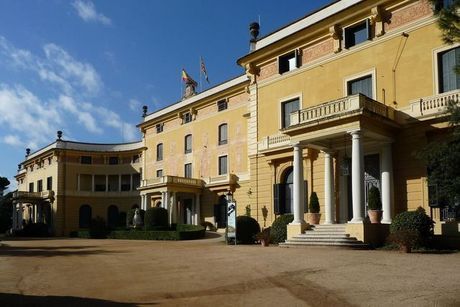Palau Reial de Pedralbes
The Royal Palace of Pedralbes serves as the Barcelona residence of the royal family of Spain. Two museums are also housed here, a ceramics museum and a museum of decorative arts.
The Royal Palace of Pedralbes was built for the King Alphonso XIII (1886-1931) between 1919 and 1929 in Renaissance style. It has big wonderful and luxuriant gardens with sculptures, fountains and arbours. The Princess Cristina, the second daughter of our King Juan Carlos I, celebrated her marriage in this palace in 1997. There is a sculpture of the Queen Elisabeth II (1833-1868) in the palace entrance, behing the front fountain. Currently the Palace host the Museums of Ceramics and Decorative Arts and it's an excellent place to official receptions.
The history of the palace began in 1918 when count Eusebi Güell donated an estate just north of Barcelona to the Royal Family. After the existing house was remodeled as a palace, King Alonso XIII moved in 1926. Work on the palace continued and it wasn't fully completed until three years later. The Italian Neoclassical design was created by the Catalan architect Eusebi Bona. During construction another Catalan architect, Francesc Nebot, took over as the lead architect.
The palace has its origins in the old Masia (mas or farmer's house) de Can Feliu, from the 17th century. The corresponding land was acquired by the count Eusebi Güell, along with the neighbouring Can Cuiàs de la Riera. Together they formed the Finca Güell, an extensive parcel of land (30,000 m2). The Can Feliu building was remodeled by the architect Joan Martorell i Montells, who built a Caribbean-style small palace, together with a Gothic-style chapel and surrounded by magnificent gardens. Later the building remodeling was given to Antoni Gaudí, together with the construction of a surrounding perimeter wall and the side entry pavilions. Gaudí also partially designed the gardens surrounding the palace, placing two fountains and a pergola and planted many Mediterranean plants like palm trees, cypress trees, magnolias, pine trees and eucalyptus. The Font d'Hércules (Hercules fountain) still exists today on site, restored in 1983; it has a bust of Hercules on top of a pillar with Catalonia's shield and a cannon in the shape of a Chinese dragon.
Eusebi Güell gave the house and garden to the Royal family, as a thank you for his noble title of Count given to him, in 1918. The house was then remodeled to become a royal palace. The work was done from 1919 to 1924 by the architects Eusebi Bona and Francesc Nebot. The palace is formed by a central building four stories high, with a chapel on the back side and two three stories high side wings that form a curve with the front facade towards the front. The outside facade is done in the Noucentisme movement style with Tuscan order columns forming two porches, with round arches and medallions and jars on the top. The interior of the building is of many styles both in decoration as in furniture, going from Louis XIV style to contemporary styles. The gardens were designed by Nicolau Maria Rubió i Tudurí, from a design that included, in a geometrically decorative area, lots of the trees already present, a pond with many decorative elements, Gaudi's fountain, bamboo benches, three lighted fountains by Carles Buïgas, the same designer of the Magic Fountain in Montjuïc and many statues such is the one of Queen Isabella II with her son Alfonso XII on the front of the palace, a work of Agapit Vallmitjana.
In 1924 it was officially made a royal palace but, with the second Spanish Republic's proclamation in 1931, it became property of the city government, which decided to make it a decorative arts museum, inaugurated in 1932. During Francisco Franco's regime it was used as a residence for Franco during his visits to the city.
The gardens at the palace, which are highly acclaimed for their beauty, were designed in 1924 by Nicolau Rubió i Tuduri. Tuduri took the property's existing trees and arranged them in a geometric layout. Lined with bamboo benches and fountains created by Carles Buigas, the garden features palm trees, cypress, cedars, lime trees, fragrant eucalyptus, magnolias, acacias, and lots of flowering plants.
Once you enter the palace you'll see an elegant hall with the main stairs and a wonderful lamp. The groud floor has a throne room and large adjoining rooms which are used today for official receptions. The first and second floors house both the Museum of Ceramics and the one of Decorative Arts.
Since 1937 Palau Reial de Pedralbes serves as the Museu de les Arts Decoratives, a museum of decorative arts. The museum has a collection of catalan glassware, porcelain, wrought iron, furniture and many utensils from the 16th to the 20th century.
Palau Reial de Pedralbes is also home to the Museu de Ceramica, a ceramics museum. Founded in 1966 and housed in the palace since 1990, this museum owns an impressive permanent collection of Spanish ceramic art spanning several centuries, from medieval pieces to contemporary works.
The Musee de Ceramica contains Spanish ceramics from the 11th century to the present. The collection would interest only the most die-hard ceramic fans, as room after room of bowl after bowl can get tedious. However, a visit to this museum is recommended because it is located in the beautiful Palau Reial, just north of the city center (Metro: Palau Reial, L3), a building that also houses the Decorative Arts Museum. There are beautiful landscaped gardens surrounding the museum, and the rooms are artfully decorated and well-lit, showcasing some beautiful architecture and design. Plus, for EUR 3.50 you receive admission to the two museums in the Palau plus the Textile Museum, so you really can't go wrong. You can get there via direct flight to Barcelona or to Girona, Reus or Lleida –Alguaire.




